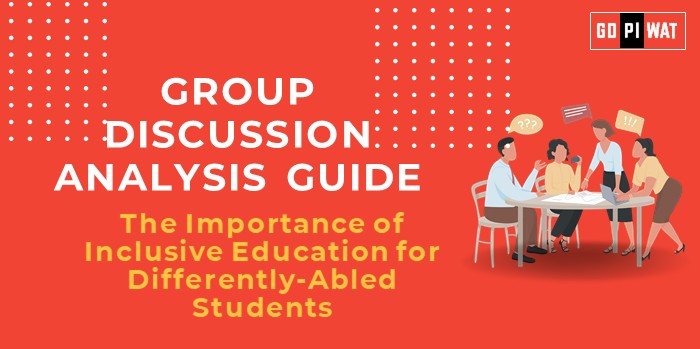📋 Group Discussion (GD) Analysis Guide: The Importance of Inclusive Education for Differently-Abled Students
🌟 Introduction to Inclusive Education
Opening Context: “Inclusive education is not just a right but a crucial pillar for building equitable societies. For differently-abled students, it ensures access to quality education and equal opportunities.”
Topic Background: The global push for inclusivity gained momentum with the UN’s Convention on the Rights of Persons with Disabilities (CRPD). In India, the Right to Education Act (2009) and the New Education Policy (2020) emphasize equitable access for diverse learners.
📊 Quick Facts and Key Statistics
- 🌍 Global Enrollment: Only 10% of children with disabilities attend school globally (UNESCO).
- 🇮🇳 India’s School Participation Rate: 60% for children with disabilities (Census 2011).
- 💰 Education Budget: Less than 1% allocated to special needs education in India.
- 🖥️ Assistive Technology Impact: Increases learning outcomes by 35% for students with disabilities (World Bank).
👥 Stakeholders and Their Roles
- 🏛️ Government: Develops policies, funds inclusive programs, and mandates accessibility standards.
- 🏫 Schools and Educators: Adapt curricula and teaching methods for diverse learning needs.
- 🤝 NGOs: Provide advocacy, resources, and teacher training for inclusive education.
- 👨👩👧👦 Parents and Communities: Offer support systems and reinforce inclusion outside school.
- 💻 Technology Providers: Develop assistive tools, like text-to-speech software and Braille-friendly resources.
🏆 Achievements and Challenges
✅ Achievements
- 📜 Policy Advancements: The RPWD Act (2016) mandates inclusive education in India.
- 📚 Accessible Learning Materials: Initiatives like NCERT textbooks in Braille empower visually impaired students.
- 🛠️ Assistive Technologies: Tools like Avaz for speech disabilities and adaptive software improve accessibility.
⚠️ Challenges
- 🏫 Infrastructure Gaps: Only 25% of schools in India are wheelchair accessible.
- 👩🏫 Teacher Training: Limited programs for educators to address special learning needs.
- 💭 Social Barriers: Persistent stigma and lack of awareness hinder inclusive opportunities.
🌍 Global Comparisons
- 🇫🇮 Finland: Personalized education plans ensure students of all abilities are accommodated.
- 🇺🇸 United States: The IDEA Act guarantees free public education for students with disabilities, promoting inclusivity.
📜 Structured Arguments for Discussion
- ✅ Supporting Stance: “Inclusive education empowers differently-abled students to achieve academic and social milestones, fostering diversity.”
- ⚠️ Opposing Stance: “Implementing inclusive education without adequate resources may compromise the quality of education for all students.”
- ⚖️ Balanced Perspective: “While inclusive education promotes equity, its success hinges on sufficient training, infrastructure, and societal support.”
🗣️ Effective Discussion Approaches
🚀 Opening Approaches
- 📈 Statistical Impact: “Globally, 90% of children with disabilities lack school access, emphasizing the urgency of inclusive education.”
- 🌍 Comparative Example: “Finland’s success with personalized education plans shows how inclusivity can benefit all students.”
- 💡 Case Study: “Kerala’s progressive implementation of digital tools has mainstreamed differently-abled students effectively.”
🔄 Counter-Argument Handling
- ⚠️ “While resources are limited, adaptive teaching methods and assistive technology offer cost-effective solutions.”
- ✅ “International models like Finland and the US demonstrate how structured policies can overcome implementation challenges.”
📊 Strategic Analysis of Strengths and Weaknesses
- ✅ Strengths: Promotes equality, social integration, and diversity.
- ⚠️ Weaknesses: Resource-intensive, requires specialized teacher training, and faces resistance.
- 🚀 Opportunities: Advances in assistive technology and alignment with global policies.
- ⚡ Threats: Budget constraints, implementation delays, and societal resistance.
🏫 Connecting with B-School Applications
- 💼 Real-World Applications: Use inclusive education as a model for corporate diversity and CSR initiatives.
- 🗣️ Sample Interview Questions:
- “How can inclusive education benefit organizational diversity and innovation?”
- “Suggest cost-effective strategies for implementing inclusive education in underdeveloped regions.”
- 💡 Insights for B-School Students: Focus on leadership, empathy, and problem-solving to design inclusive models applicable to education and organizations.


